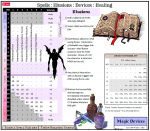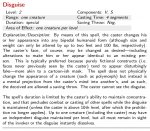I think the bullet points are all good rephrasings.
How and when does the player's saving throw come into play? If a player ignores the illusion (e.g. the wall of illusionary fire heading at him while he stands in a pool of real oil, per your example), does he (or she) get a saving throw before taking damage (if not actively disbelieving)? If they decide to close their eyes, what then? What about if they are actively ignoring the illusion? Is a saving throw required, or are they automatically immune to the damage effects by virtue of their bold action?
If the player doesn't suspect an illusion then run saves however you would if the phenomenon were real; no different.
If a player ignores a phenomena because they suspect its an illusion I roll a disbelieve check. Just like searching for secret doors, this is rolled whether a door/illusion is actually present or not. If no door/illusion is present then that was a waste of time for the player and I'm just going through motions. If the phenomena is an illusion and they fail the disbelieve check then I tell them nothing seems unusual. If the illusion was "attacking" them during this process, I'm rolling and applying damage however a real version of that would apply if such were present. If that includes a saving throw (illusionary ogre magi casts cone of cold; cone of cold has a save) then the save is rolled as normal and would halve the damage they get from the illusionary cone of cold.
If they closed their eyes to the fire in the pool of oil they'd get a serious bonus to their save. A rule of thumb would be if you'd give a minus to the save due to their chosen vulnerability to the phenomena if it were real, then that should invert to a bonus if it is illusionary. So if someone just stood there and leaned into the fire to "prove" it was fake I'd only let them fail on a very low roll - 1-3, say. (Sometimes your mind just won't cooperate). But conversely if that fire were real I'd treat any "1s" I rolled for damage as "2s", because the player wasn't even trying to avoid burning in the least bit.
I base everything on buy-in. If you buy-in, you're in a tough spot. Once you've bought in you can't just decide to stop buying in - you can still try, but your conscious mind is fighting your subconscious mind at that point and I give fewer bonuses to the disbelieve check as compared to someone suspicious from the get-go.
Do you (as Huso does above) give the PC an automatic---i.e. PC-intelligence based vs.player-intelligence based---chance of detection? It sounds like you allow for that with NPC/monsters because without random input, the DM is too all-knowing and biased.
PCs are dependent on the player becoming suspicious, absent spells or some such providing concrete feedback to the PC's player. It's not really all that different from detecting magic. What do parties do if they don't have detect magic at hand but think something might be magical? They become suspicious because of something that seems different from non-magical items - but if they had a spell they could simply cast it in a precautionary fashion and know for sure without ever coming across something that seemed "off"; "Oh, that plain sword is magic? Who would've guessed". Same with illusions - "Wow we walked past that wall a dozen times and never suspected it wasn't real!"
Now, will I use exceptions to the above "rule" on an ad hoc basis? Sure, I'm a very ad hoc guy. If a PC cleric would be an expert on what it's enemy order's holy symbol looked like, and I think the NPC illusionist-enemy wouldn't be, for some reason, I might say that an illusionary cleric of that enemy order created by the NPC illusionist had a screwy looking holy symbol without prompting by a player inquiry. I'll start dropping info that something seems different. And to your point about "what if I think I didn't give enough info and my players didn't get what I think is a fair chance to become suspicious" - then ad hoc a save bonus based around the difference between what you think the players received vs what you wish you'd have given them.
Do you (as Huso above) make illusions disappear as soon as damage is dealt? 1e BtB?
I'm not sure what Anthony is reading that leads to this conclusion. The shadow monster spell is referenced but I don't see anything like that in the spell.
Explanation/Description: The shadow monsters spell enables the illusionist
to create semi-real phantasms of one or more monsters. The total hit dice
of the shadow monster or monsters thus created cannot exceed the level of
experience of the illusionist; thus a 10th level illusionist can create one
creature which has 10 hit dice (in normal circumstances), two which have
5 hit dice (normally), etc. All shadow monsters created by one spell must
be of the same sort, i.e. hobgoblins, orcs, spectres, etc. They have 20% of
the hit points they would normally have. To determine this, roll the
appropriate hit dice and multiply by 20, any score less than .4 is dropped
- in the case of monsters with one (or fewer) hit dice, this indicates the
monster was not successfully created - and scores of .4 or greater are
rounded up to one hit point. If the creature or creatures viewing the
shadow monsters fail their saving throw and believe the illusion, the
shadow monsters perform as normal with respect to armor class and attack
forms. If the viewer or viewers make their saving throws, the shadow
monsters are armor class 10 and do only 20% of normal melee damage
(biting, clawing, weapon, etc.), dropping fractional damage less than .4 as
done with hit points. Example: A shadow monster dragonne attacks a
person knowing it is only quasi-real. The monster strikes with 2 claw
attacks and 1 bite, hitting as a 9 die monster. All 3 attacks hit, and the
normal damage dice are rolled: d8 scored 5, d8 scores 8,3d6 scores 11 and
each total is multiplied by .2 (.2 X 5 = 1, .2 X 8 = 1.6 = 2, .2 X 11 = 2.2
= 2) and 5 hit points of real damage are scored upon the victim.
I don't see anything there that's ever led me to interpret that illusions fade after doing damage. I don't believe "shadow" class magic can be used to interpret the phantasmal family (PF, IPF, SF, etc.) In the DMG spell explanations, it has this to say about the 5th level illusions spell shadow magic that mimics fireballs, etc., and which I apply in principle to all "shadow" illusion spells:
Shadow Magic: The caster is actually tapping a power source, even though the majority of the spell is illusion, thus the 1 hit point of damage
per level of the caster.
So when I see shadow-type magic differentiated with the words "quasi-real" or "semi-real", as opposed to "unreal", I tend to put them in their own distinct cul-de-sac of magic.
Do illusions disappear when touched? For example, an illusion of an passage blocked by iron bars. A PC swings a hammer at the bars---nothing visually or audible is going to make his or her swing rebound.
It depends on the illusion. The DMG spell commentary for phantasmal force (in the 3rd level MU spells section) says this for illusionary combatants (fake orc or whatever):
The illusion lasts until struck by an opponent - unless the spell caster causes the illusion to
react appropriately - or until the magic-user ceases concentration upon
the spell (due to desire, moving, or successful attack which causes
damage).
Note on that last sentence that the successful attacking causing damage is to the caster, not the illusion. An illusion sticking around to puppet their illusion directly is a much more powerful illusion (but the illusionist can't do anything else). One that was not so directed would disappear when struck because it couldn't react to being struck.
For stuff like doors, bars, walls - has the player already accepted them as real? If so, the illusion itself may not stop the hammer but the player's mind might cause the arm to act as if it did. A character running down a corridor with no light could run through an illusionary wall they never saw, that a group with torches would never allow themselves to "walk through".
None of this actually changes physics, so if the group with torches threw a pebble at a wall it would go through the wall instead of bouncing off. That might be enough to disbelieve (huge bonus). But if they accepted the wall as real once there's no certainty their mind will ever accept it as unreal, and treat it as not-wall. If their mind won't accept it as illusion then they couldn't walk through it voluntarily, but might be tossed through it by another.
Why do people (e.g. this Ricks fella) get so defensive and offended when others disagree with them? (Don't bother to answer that.)
To be fair to Ricks, I wasn't very charitable to him either. He's a decent guy, but he represents what I would call the "80s Dragon Mag" school of approaching D&D and I'm very much not. So sparks and disagreements.
I may not have the chops as a DM to drop all necessary clues that will allow a skilled player to make informed choices.
Practice makes perfect. Use it in small doses that aren't campaign changing until you're comfortable with how you want to run it. Then if you think you made a mistake it's easy to mitigate.
I watched an original Twilight Zone episode recently
Run it as you feel comfortable; how I do it may not be for everyone


